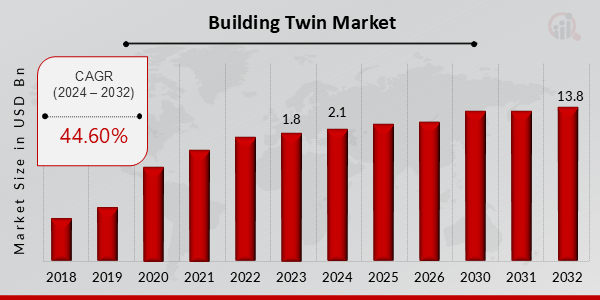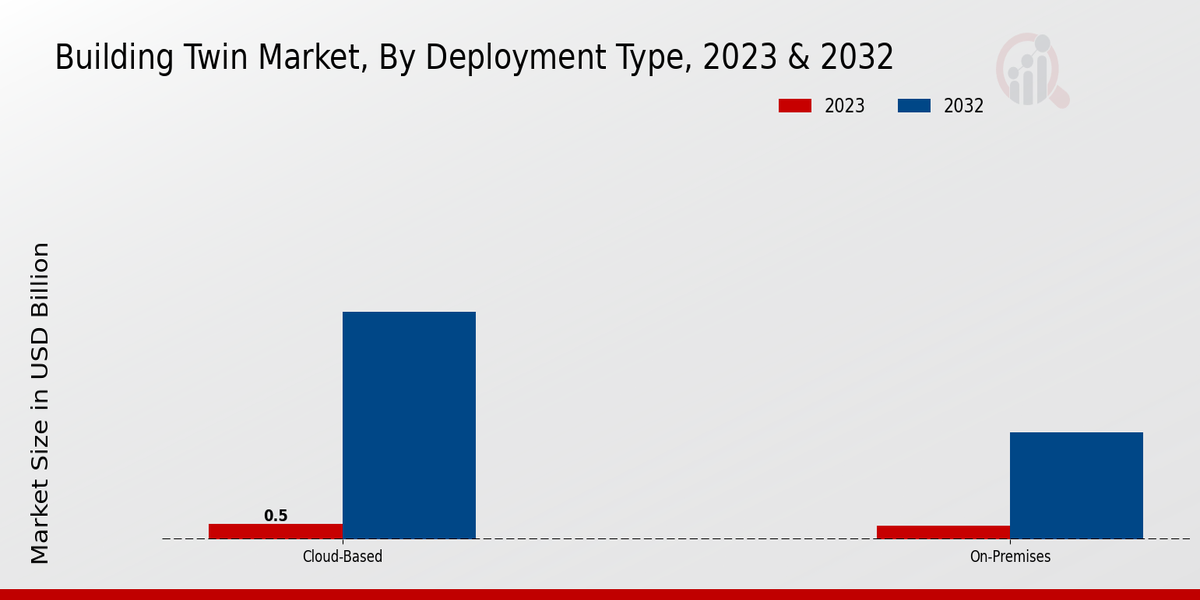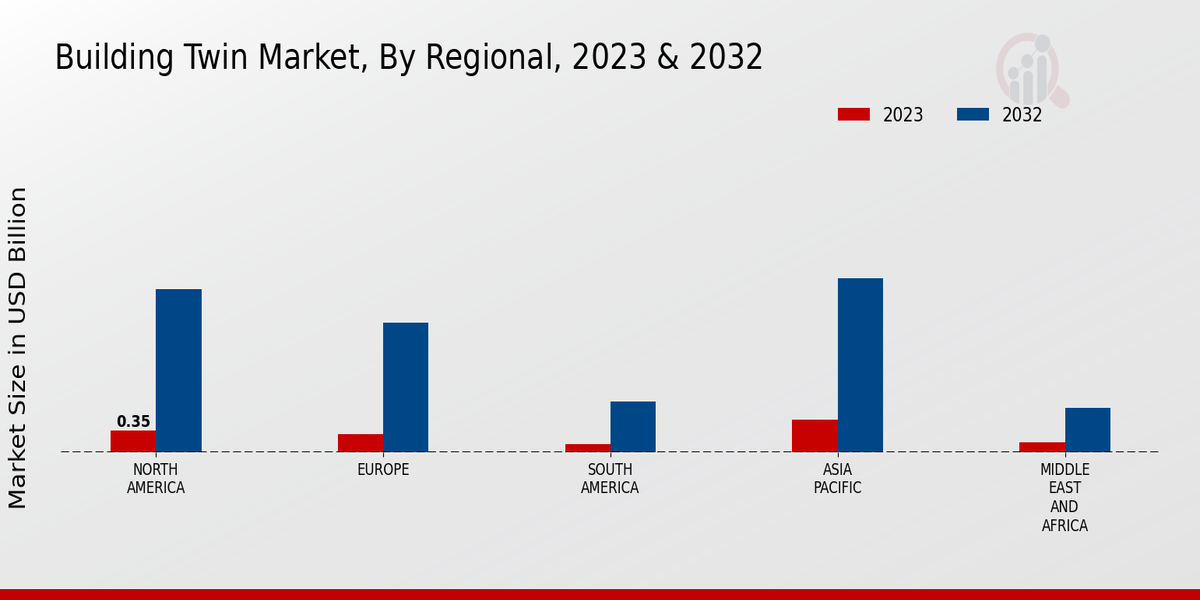Global Building Twin Market Overview:
Building twin market size was estimated at 1.8 (USD Billion) in 2023. The building twin market industry is expected to grow from 2.1 (USD Billion) in 2024 to 13.8 (USD Billion) by 2032. The building twin market CAGR (growth rate) is expected to be around 44.60% during the forecast period (2024-2032).
Key Building Twin Market Trends Highlighted
Key market drivers of the Building Twin Market include the increasing demand for digital buildings, the growing need for real-time building performance monitoring, and the rise of the Internet of Things (IoT) in the construction industry.
Opportunities can be explored or captured in the market by developing innovative building twin solutions, integrating artificial intelligence (AI) and machine learning (ML) technologies, and expanding into emerging markets. Recent trends in the market include the adoption of cloud-based building twin platforms, the growing use of digital twins for building retrofits and renovations, and the emergence of open data standards for building twins.

Source: Primary Research, Secondary Research, MRFR Database and Analyst Review
Building Twin Market Drivers
Rising Adoption of Digital Twin Technology
The increasing adoption of digital twin technology is a key driver of the Building Twin Market. Digital twins are virtual representations of physical assets, processes, and systems that can be used to monitor, analyze, and optimize performance. Building twins are digital representations of buildings that can be used to track and manage building performance, energy consumption, and occupant comfort.
The adoption of digital twin technology is expected to grow significantly in the coming years as more and more organizations recognize the benefits of this technology. The growing adoption of digital twin technology is creating a strong demand for building twin solutions, which is driving the growth of the Building Twin Market.
Increasing Demand for Energy Efficiency
The increasing demand for energy efficiency is another key driver of the Building Twin Market. Buildings are responsible for a significant portion of global energy consumption, and there is a growing demand for solutions that can help to reduce energy consumption and improve energy efficiency.
Building twins can be used to track and monitor energy consumption, identify areas of waste, and optimize energy performance. By leveraging data and analytics, building twins can help organizations to reduce energy consumption and improve energy efficiency, which is leading to the growth of the Building Twin Market.
Government Regulations and Initiatives
Government regulations and initiatives are also driving the growth of the Building Twin Market. Governments around the world are increasingly implementing regulations and initiatives that promote energy efficiency and sustainability in buildings. These regulations and initiatives are creating a demand for solutions that can help organizations to meet these requirements.
Building twins can be used to track and monitor compliance with regulations, and to identify opportunities for improvement. By leveraging data and analytics, building twins can help organizations to meet government regulations and initiatives, which is driving the growth of the Building Twin Market.
Building Twin Market Segment Insights:
Building Twin Market Deployment Type Insights
The deployment type segment is categorized into cloud-based and on-premises. Cloud-based deployment offers benefits such as scalability, flexibility, and cost-effectiveness, making it a popular choice for businesses of all sizes.
This growth is attributed to the increasing adoption of cloud computing technologies across various industries, including the construction and real estate sectors. On-premises deployment, on the other hand, involves installing and maintaining the Building Twin software on the organization's own servers.
This deployment type provides greater control and security over data, which may be a critical consideration for certain businesses. The on-premises segment is also expected to experience significant growth, albeit at a slower pace compared to the cloud-based segment.
The choice between cloud-based and on-premises deployment depends on various factors, including the organization's size, IT infrastructure, and specific requirements. Cloud-based deployment is typically more suitable for businesses that require scalability, flexibility, and cost-effectiveness, while on-premises deployment may be preferred by organizations that prioritize data security and control.

Source: Primary Research, Secondary Research, MRFR Database and Analyst Review
Building Twin Market Vertical Insights
The Building Twin Market is segmented into various industry verticals, including Commercial, Residential, and Industrial. Among these, the Commercial segment is expected to dominate the market, accounting for a significant share of the Building Twin Market revenue in 2024. The growth of the Commercial segment can be attributed to the increasing adoption of Building Twin technology in commercial buildings for enhanced energy efficiency, space optimization, and improved occupant comfort. The Residential segment is also expected to witness significant growth, driven by the rising demand for smart homes and the increasing awareness of the benefits of Building Twin technology. The Industrial segment is expected to grow at a steady pace, as Building Twin technology is increasingly used in industrial facilities for predictive maintenance, process optimization, and safety management.
Building Twin Market Application Insights
The Building Twin Market is segmented by application into facility management, design and construction, energy efficiency, and sustainability. The Design and Construction segment is also expected to witness substantial growth during the forecast period, owing to the increasing adoption of building information modeling (BIM) and other advanced technologies in the construction industry.
The energy efficiency segment is anticipated to grow at a steady pace due to the rising demand for energy-efficient buildings. The Sustainability segment is expected to gain traction in the coming years, driven by the growing awareness of environmental sustainability and the need for green buildings. Overall, the Building Twin Market is expected to exhibit robust growth, with a CAGR of 31.99% projected from 2024 to 2032, reaching a valuation of 9.96 billion USD by 2032.
Building Twin Market Tech Stack Insights
The tech stack segment plays a critical role in driving market growth within the Building Twin Market, with key components including IoT sensors, data analytics, and visualization software. IoT sensors, valued at USD 0.23 billion in 2023, are expected to reach USD 2.62 billion by 2032, reflecting a CAGR of 32.4%.
The integration of IoT sensors enables real-time data collection, enhancing building efficiency, predictive maintenance, and occupant comfort. Data Analytics, valued at USD 0.18 billion in 2023, is projected to reach USD 2.21 billion by 2032, growing at a CAGR of 32.9%.
Advanced data analytics tools facilitate data interpretation, enabling informed decision-making, optimizing building performance, and uncovering valuable insights. Visualization Software, valued at USD 0.15 billion in 2023, is anticipated to reach USD 1.82 billion by 2032, exhibiting a CAGR of 33.2%. These software solutions provide interactive visualizations that simplify complex data, enabling stakeholders to easily understand building performance, identify trends, and make data-driven decisions.
Building Twin Market Data Source Insights
The Building Twin Market is segmented by data source into BIM models, operational data, and IoT Data. BIM Models are expected to account for the largest share of the market in 2023, due to the increasing adoption of BIM in the construction industry.
Operational data is expected to grow at the highest CAGR during the forecast period, due to the growing need for real-time data to improve building performance. IoT data is expected to play a significant role in the future of the building twin market, as it can provide real-time data from sensors and other devices to create a more accurate and comprehensive digital twin of a building.
Building Twin Market Regional Insights
The Building Twin Market is segmented into North America, Europe, APAC, South America, and MEA. North America is the largest regional market, accounting for approximately 35% of the global revenue in 2023. The region is expected to continue to dominate the market throughout the forecast period, growing at a CAGR of 32.5% from 2024 to 2032.
Europe is the second-largest regional market, with a market share of approximately 28% in 2023. The region is expected to grow at a CAGR of 31.8% from 2024 to 2032. APAC is the fastest-growing regional market, with a CAGR of 33.1% expected from 2024 to 2032. The region is expected to account for approximately 22% of the global revenue by 2032. South America and MEA are expected to grow at CAGRs of 30.2% and 29.7%, respectively, from 2024 to 2032.

Source: Primary Research, Secondary Research, MRFR Database and Analyst Review
Building Twin Market Key Players and Competitive Insights:
Major players strive to gain a competitive advantage over their rivals. Some of the key strategies employed by these players include product innovation, strategic partnerships, and acquisitions. The industry is characterized by intense competition, with leading players aggressively pursuing market share.
The landscape is expected to remain highly competitive in the coming years. Leading Building Twin Market players are expected to invest heavily in research and development to drive innovation and gain a competitive edge.
Bentley Systems is a leading provider of building twin software. The company's products are used by a wide range of organizations, including architects, engineers, contractors, and owners. Bentley Systems has a strong track record of innovation, and its products are known for their quality and reliability. The company has a global presence, with offices in over 50 countries. Bentley Systems is committed to providing its customers with the best possible experience, and its products are backed by a team of experts who are always available to help.
AVEVA is a leading provider of Building Twin Market software and services. The company's products are used by a wide range of organizations, including oil and gas companies, power plants, and manufacturing facilities. AVEVA has a strong track record of innovation, and its products are known for their reliability and ease of use. The company has a global presence, with offices in over 40 countries. AVEVA is committed to providing its customers with the best possible experience, and its products are backed by a team of experts who are always available to help.
Key Companies in the Building Twin Market Include:
Building Twin Market Developments
The Building Twin Market is projected to grow from USD 0.82 billion in 2023 to USD 9.96 billion by 2032, exhibiting a CAGR of 31.99% during the forecast period. Market growth is primarily driven by increasing adoption of building information modeling (BIM) and digital twin technology, rising investment in smart city development, and growing demand for energy efficiency in buildings.
Recent developments in the market include strategic partnerships and collaborations between key players to enhance product offerings and expand market reach. For instance, in 2023, Siemens and Bentley Systems announced a partnership to integrate their digital twin solutions, providing a comprehensive platform for building owners and operators.
The market is characterized by a competitive landscape with established players and emerging startups offering a range of Building Twin solutions. Some of the prominent players operating in the market include Siemens, Bentley Systems, Autodesk, Dassault Systmes, and IBM.
Building Twin Market Segmentation Insights
Building Twin Market Deployment Type Outlook
Building Twin Market Vertical Outlook
-
Commercial
-
Residential
-
Industrial
Building Twin Market Application Outlook
-
Facility Management
-
Design and Construction
-
Energy Efficiency
-
Sustainability
Building Twin Market Tech Stack Outlook
-
IoT Sensors
-
Data Analytics
-
Visualization Software
Building Twin Market Data Source Outlook
-
BIM Models
-
Operational Data
-
IoT Data
Building Twin Market Regional Outlook
-
North America
-
Europe
-
South America
-
Asia Pacific
-
Middle East and Africa
| Report Attribute/Metric |
Details |
| Market Size 2023 |
1.8 (USD Billion) |
| Market Size 2024 |
2.1 (USD Billion) |
| Market Size 2032 |
13.8 (USD Billion) |
| Compound Annual Growth Rate (CAGR) |
44.60% (2024-2032) |
| Report Coverage |
Revenue Forecast, Competitive Landscape, Growth Factors, and Trends |
| Base Year |
2023 |
| Market Forecast Period |
2024-2032 |
| Historical Data |
2019-2023 |
| Market Forecast Units |
USD Billion |
| Key Companies Profiled |
AVEVA, Software AG, PTC, SAP SENewparaHexagon AB, Siemens, GE Digital, Johnson Controls, Trimble Inc., Oracle Corporation, Autodesk, Siemens Digital Industries Software, Schneider Electric, Bentley Systems |
| Segments Covered |
Deployment Type, Industry Vertical, Application, Tech Stack, Data Source, Region |
| Key Market Opportunities |
Digital transformation Smart city development Growing demand for energy efficiency Focus on sustainability Advancements in IoT and AI |
| Key Market Dynamics |
Growing investment in digital transformation Adoption of IoT and AI technologies Increasing demand for energy efficiency Focus on sustainability and resilience Emergence of cloud-based solutions |
| Countries Covered |
North America, Europe, APAC, South America, MEA |
Frequently Asked Questions (FAQ) :
The Building Twin Market is expected to be valued at approximately USD 1.8 Billion in 2023.
The Building Twin Market is projected to reach a valuation of around USD 13.8 Billion by 2032.
The Building Twin Market is anticipated to grow at a CAGR of approximately 44.60% during the forecast period from 2024 to 2032.
North America is expected to dominate the Building Twin Market in 2032.
Key applications of Building Twin technology include design optimization, construction planning, and facility management.
Prominent players in the Building Twin Market include Siemens, Bentley Systems, and IBM.
Rising demand for energy efficiency, increasing adoption of digital technologies, and government initiatives are driving the growth of the Building Twin Market.
Challenges in the Building Twin Market include data security concerns, lack of skilled professionals, and high implementation costs.
Emerging trends in the Building Twin Market include the integration of AI and ML, the use of cloud computing, and the development of open standards.
Building Twin technology transforms the construction industry by improving collaboration, enhancing decision-making, and optimizing project outcomes.

















